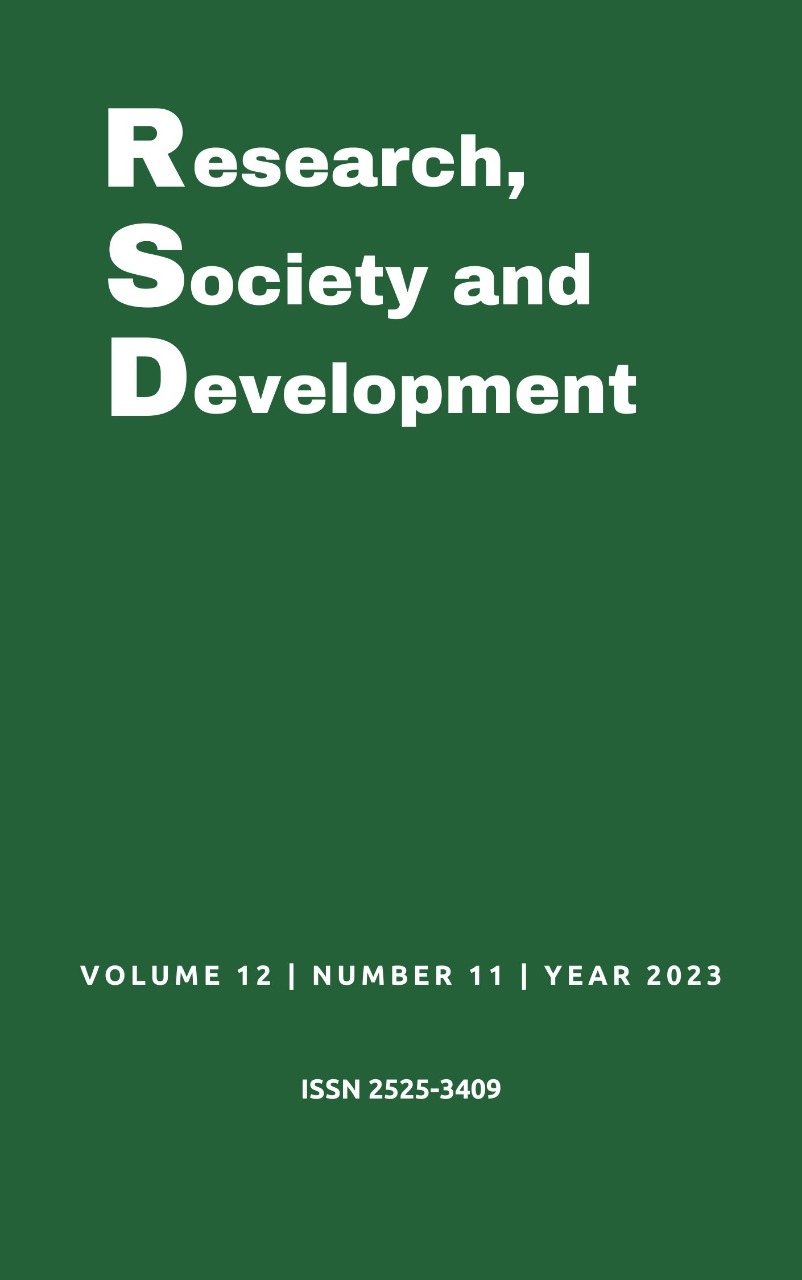Childhood obesity in Brazil: A literature review
DOI:
https://doi.org/10.33448/rsd-v12i11.43699Keywords:
Obesity; Child nutrition; Brazil.Abstract
Introduction: Childhood obesity is a growing disease in Brazil and around the world, being a public health problem. The WHO estimate is that this number will reach 11.3 million in 2025. Objective: To evaluate the panorama of childhood obesity in Brazil, nationally and regionally, as well as its causes. Methodology: The research was carried out in September 2023, 16,247 articles were found in the databases, and 14 articles were selected to make up this narrative bibliographic review. Results: It was observed that female children are more affected by obesity than male children. Furthermore, the Brazilian regions with the highest rates of childhood obesity are the South and Southeast regions. Conclusion: It is concluded that childhood obesity has been growing alarmingly in Brazil due to several factors and requires urgent action to combat this threat to public health and children's well-being.
References
Aranha, L. N., & Oliveira, G. M. M. de. (2020). Circunferência da cintura, uma medida simples para a obesidade infantil? Arquivos Brasileiros de Cardiologia, 114, 538-539.
Barbosa, L. M. de A., et al. (2019). Prevalência e fatores associados ao excesso de peso em adolescentes de uma comunidade de baixa renda - Nordeste, Brasil. Revista Brasileira de Saúde Materno Infantil, 19(3), Jul-Set 2019.
BBC News Brasil. (2023). Brasil terá 11,3 milhões de crianças obesas em 2025, estima organização. https://www.bbc.com/portuguese/geral-41588686
Caixeta, H. C. V., & Amato, A. A. (2020). Factors associated with overweight and abdominal obesity in Brazilian school-aged children: a comprehensive approach. Archives of Endocrinology and Metabolism, 64(4).
Caixeta, H. C. V., & Amato, A. A. (2020). Factors associated with overweight and abdominal obesity in Brazilian school-aged children: a comprehensive approach. Archives of Endocrinology and Metabolism, 64(4).
Camargos, A. C. R., et al. (2019). Prevalência de sobrepeso e obesidade no primeiro ano de vida nas Estratégias de Saúde da Família. Cadernos Saúde Coletiva, 27(1), 32-38.
Conde, W. L., et al. (2018). Nutritional status of Brazilian schoolchildren: National Adolescent School-Based Health Survey 2015. Revista Brasileira de Epidemiologia, 21.
Corrêa, V. P., et al. (2020). Impacto da obesidade infantil no Brasil: revisão sistemática. RBONE - Revista Brasileira de Obesidade, Nutrição e Emagrecimento, 14(85), 177-183.
Eskenazi, E. M. de S., et al. (2018). Fatores socioeconômicos associados à obesidade infantil em escolares do município de Carapicuíba (SP, Brasil). Revista Brasileira de Ciências da Saúde, 22, 247-254.
Ferrari, G. L. de M., Victo, E. R. de, & Matsudo, V. K. R. (2018). Estudo internacional de obesidade infantil, estilo de vida e ambiente (ISCOLE) Brasil. Diagnóstico & Tratamento, 2(3), 109-115.
Ferreira, C. M., et al. (2021). Prevalence of childhood obesity in Brazil: systematic review and meta-analysis. Jornal de Pediatria, 97(5).
Folmann, A. G., et al. (2021). Prevalência de excesso de peso em adolescentes de uma cidade do sul do Brasil, de acordo com diferentes índices antropométricos. Revista Paulista de Pediatria, 39.
Godinho, A. S., et al. (2019). Principais fatores relacionados à obesidade infantil na atualidade. RENEF, 9(13), 2019.
Lopes, P. C. S., et al. (2010). Fatores de risco associados à obesidade e sobrepeso em crianças em idade escolar. Revista Brasileira de Enfermagem, 63(1), 73-78.
Lopes, A. F. (2018). Evolução do estado nutricional em crianças na idade pré-escolar (Tese de Doutorado, Universidade de São Paulo).
Medeiros, A. J. de, et al. (2020). Longitudinal monitoring of nutritional status of schoolchildren at a public school. Portal Regional da BVS, 30(2), 209-215.
Ministério da Educação (MEC). (2018). Obesidade infantil é tema do programa Salto para o Futuro. http://portal.mec.gov.br/component/tags/tag/obesidade-infantil#:~:text=Obesidade%20infantil%20é%20tema%20do%20programa%20Salto%20para%20o%20Futuro&text=No%20Brasil%2C%209%2C4%25,para%20classificar%20a%20obesidade%20infantil. Acesso em: 9 de out. 2023.
Ministério da Saúde. (2021). Obesidade infantil afeta 3,1 milhões de crianças menores de 10 anos no Brasil. https://www.gov.br/saude/pt-br/assuntos/noticias/2021/junho/obesidade-infantil-afeta-3-1-milhoes-de-criancas-menores-de-10-anos-no-brasil
Ministério da Saúde. (2022). Obesidade infantil é fator de risco para doenças respiratórias, colesterol alto, diabetes e hipertensão. https://aps.saude.gov.br/noticia/17518#:~:text=Considerada%20um%20problema%20de%20sa%C3%BAde,no%20agravamento%20de%20doen%C3%A7as%20respirat%C3%B3rias.
Mello, E. R. B., & Guedes, D. P. (2021). Prevalence of overweight and obesity among Brazilian children and adolescents: systematic review and meta-analysis. ABCS Health Science, 39(1).
Miranda, J. M. de Q., et al. (2015). Prevalência de sobrepeso e obesidade infantil em instituições de ensino: públicas vs. privadas. Revista Brasileira de Medicina do Esporte, 21, 104-107.
Porto, N. B., et al. (2021). Panorama da obesidade em crianças brasileiras cadastradas no SISVAN: análise de uma década. Scientia Medica, 31, 1-8.
Rother, E. T. (2007). Revisão sistemática x revisão narrativa. Acta Paulista de Enfermagem, 20(2). https://doi.org/10.1590/S0103-21002007000200001
Santos, L. R. C., & Rabinovich, E. P. (2011). Situações familiares na obesidade exógena infantil do filho único. Saúde e Sociedade, 20(2), 507-521.
Downloads
Published
How to Cite
Issue
Section
License
Copyright (c) 2023 Maria Fernanda Santa Rosa Santos; Sthefani Lima Tamelini ; Giovanna de Paula Rosado; Milene Fernandes Aguiar ; Marcelo Rodrigo Tavares

This work is licensed under a Creative Commons Attribution 4.0 International License.
Authors who publish with this journal agree to the following terms:
1) Authors retain copyright and grant the journal right of first publication with the work simultaneously licensed under a Creative Commons Attribution License that allows others to share the work with an acknowledgement of the work's authorship and initial publication in this journal.
2) Authors are able to enter into separate, additional contractual arrangements for the non-exclusive distribution of the journal's published version of the work (e.g., post it to an institutional repository or publish it in a book), with an acknowledgement of its initial publication in this journal.
3) Authors are permitted and encouraged to post their work online (e.g., in institutional repositories or on their website) prior to and during the submission process, as it can lead to productive exchanges, as well as earlier and greater citation of published work.

